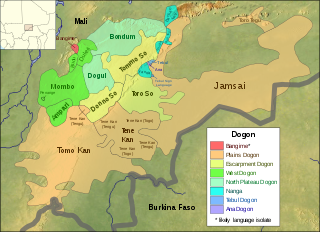Related Research Articles

Fijian is an Austronesian language of the Malayo-Polynesian family spoken by some 350,000–450,000 ethnic Fijians as a native language. The 2013 Constitution established Fijian as an official language of Fiji, along with English and Fiji Hindi and there is discussion about establishing it as the "national language". Fijian is a VOS language.
Taba is a Malayo-Polynesian language of the South Halmahera–West New Guinea group. It is spoken mostly on the islands of Makian, Kayoa and southern Halmahera in North Maluku province of Indonesia by about 20,000 people.

Dameli (دَميلي), also Damia, Damɛ̃ḍī, Dāmia bāṣa or Gidoj, is an Indo-Aryan language of the Dardic subgroup spoken by approximately 5,000 people in the Domel Town, in the Chitral District of Khyber-Pakhtunkhwa province of Pakistan.
The Nafsan language, also known as South Efate or Erakor, is a Southern Oceanic language spoken on the island of Efate in central Vanuatu. As of 2005, there are approximately 6,000 speakers who live in coastal villages from Pango to Eton. The language's grammar has been studied by Nick Thieberger, who has produced a book of stories and a dictionary of the language.
Manam is a Kairiru–Manam language spoken mainly on the volcanic Manam Island, northeast of New Guinea.
Tamambo, or Malo, is an Oceanic language spoken by 4,000 people on Malo and nearby islands in Vanuatu. It is one of the most conservative Southern Oceanic languages.
Cavineña is an indigenous language spoken on the Amazonian plains of northern Bolivia by over 1,000 Cavineño people. Although Cavineña is still spoken, it is an endangered language. Guillaume (2004) states that about 1200 people speak the language, out of a population of around 1700. Nearly all Cavineña are bilingual in Spanish.
Hoava is an Oceanic language spoken by 1000–1500 people on New Georgia Island, Solomon Islands. Speakers of Hoava are multilingual and usually also speak Roviana, Marovo, Solomon Islands Pijin, English.
Ughele is an Oceanic language spoken by about 1200 people on Rendova Island, located in the Western Province of the Solomon Islands.

Bangime is a language isolate spoken by 3,500 ethnic Dogon in seven villages in southern Mali, who call themselves the bàŋɡá–ndɛ̀. Bangande is the name of the ethnicity of this community and their population grows at a rate of 2.5% per year. The Bangande consider themselves to be Dogon, but other Dogon people insist they are not. Bangime is an endangered language classified as 6a - Vigorous by Ethnologue. Long known to be highly divergent from the (other) Dogon languages, it was first proposed as a possible isolate by Blench (2005). Heath and Hantgan have hypothesized that the cliffs surrounding the Bangande valley provided isolation of the language as well as safety for Bangande people. Even though Bangime is not closely related to Dogon languages, the Bangande still consider their language to be Dogon. Hantgan and List report that Bangime speakers seem unaware that it is not mutually intelligible with any Dogon language.
Biak, also known as Biak-Numfor, Noefoor, Mafoor, Mefoor, Nufoor, Mafoorsch, Myfoorsch and Noefoorsch, is an Austronesian language of the South Halmahera-West New Guinea subgroup of the Eastern Malayo-Polynesian languages.
Farefare or Frafra, also known by the regional name of Gurenne (Gurene), is a Niger–Congo language spoken by the Frafra people of northern Ghana, particularly the Upper East Region, and southern Burkina Faso. It is a national language of Ghana, and is closely related to Dagbani and other languages of Northern Ghana, and also related to Mossi, also known as Mooré, the national language of Burkina Faso.

Iatmul is the language of the Iatmul people, spoken around the Sepik River in the East Sepik Province, northern Papua New Guinea. The Iatmul, however, do not refer to their language by the term Iatmul, but call it gepmakudi.
Mav̋ea is an Oceanic language spoken on Mavea Island in Vanuatu, off the eastern coast of Espiritu Santo. It belongs to the North–Central Vanuatu linkage of Southern Oceanic. The total population of the island is approximately 172, with only 34 fluent speakers of the Mav̋ea language reported in 2008.
Tawala is an Oceanic language of the Milne Bay Province, Papua New Guinea. It is spoken by 20,000 people who live in hamlets and small villages on the East Cape peninsula, on the shores of Milne Bay and on areas of the islands of Sideia and Basilaki. There are approximately 40 main centres of population each speaking the same dialect, although through the process of colonisation some centres have gained more prominence than others.
Lewo is an Oceanic language spoken on Epi Island, in Vanuatu.

Vamale (Pamale) is a Kanak language of northern New Caledonia. The Hmwaeke dialect, spoken in Tiéta, is fusing with Haveke and nearly extinct. Vamale is nowadays spoken in Tiendanite, We Hava, Téganpaïk and Tiouandé. It was spoken in the Pamale valley and its tributaries Vawe and Usa until the colonial war of 1917, when its speakers were displaced.

Toʼabaita, also known as Toqabaqita, Toʼambaita, Malu and Maluʼu, is a language spoken by the people living at the north-western tip of Malaita Island, of South Eastern Solomon Islands. Toʼabaita is an Austronesian language.
Neveʻei, also known as Vinmavis, is an Oceanic language of central Malekula, Vanuatu. There are around 500 primary speakers of Neveʻei and about 750 speakers in total.
Longgu (Logu) is a Southeast Solomonic language of Guadalcanal, but originally from Malaita.
References
- Corston, Simon H. (1996) Ergativity in Roviana, Solomon Islands. Canberra: Pacific Linguistics.
- Corston-Oliver, Simon H. (2002) 'Roviana.' In John Lynch, Malcolm Ross & Terry Crowley (eds.) The Oceanic languages. London: Curzon. [A lengthy sketch grammar of the language.]
- Hall, Allen.(2000). A Roviana and English dictionary/Allen and others for New Georgia, Solomon Islands. Brisbane.Jollen Press.
- Ray, Sidney H. (1926) A comparative study of the Melanesian island languages. Cambridge: Cambridge University Press. [Briefly describes a few key features of the grammar of Roviana.]
- Ross, Malcolm D. (1988) Proto Oceanic and the Austronesian languages of western Melanesia. Canberra: Pacific Linguistics. [pp240–247 discusses clause structure in Roviana.]
- Todd, Evelyn M. (1978) 'Roviana syntax.' In Stephen A. Wurm & Lois Carrington (eds.) Second International Conference on Austronesian Linguistics: Proceedings fascicle 2. Eastern Austronesian. Canberra: Pacific Linguistics. pp1035–1042.
- Todd, Evelyn M. (2000) 'Roviana clauses.' In Bill Palmer & Paul Geraghty (eds.) SICOL. Proceedings of the Second International Conference on Oceanic Linguistics: vol.2. Historical and descriptive studies. Canberra: Pacific Linguistics. pp137–154.
- Waterhouse, J.H.L. (1928) A Roviana and English dictionary. Sydney: Epworth. (Revised and enlarged 1949 by L.M. Jones and edited by Loata Parkinson in 2005).